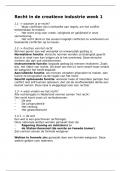Samenvatting
Complete summary for Innovation Management + Recap notes
- Instelling
- Universiteit Van Amsterdam (UvA)
Full summary needed for the exam and additionally I included summary of the summary (Recap) which includes main points necessary for the exam. These points are based on lectures, past exams and repeated things.
[Meer zien]














